
NPS Photo by: Mitch Smith 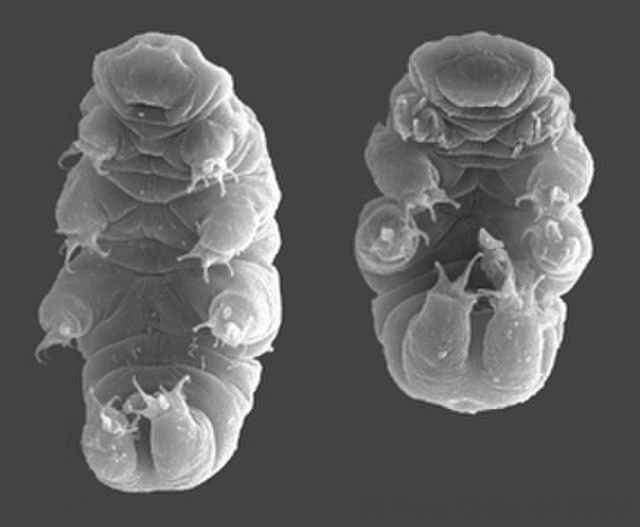
CC Photo of Tardigrade Hypsibiusdujardini using SEM by Willow Gabriel of Goldstein Labs ExtremophilesScientific knowledge of the environmental limits of microbial life on Earth expanded dramatically in the early 1990s as microbiologists applied new techniques of molecular biology over a broad range of environmental extremes. New discoveries have revolutionized scientific understanding of Earth's biosphere, opened up new views of the history of land-based life, and increased the possibilities that life could exist elsewhere in the cosmos. Scientists found tiny species living in places that were previously unimagined.Extremophiles (literally "extreme-loving") are defined as organisms that occupy environments judged by human standards as harsh. These encompass both physical and chemical extremes. Different classes of extremophiles have been defined based on the nature of the environments where they are found. ThermophilesThough many think the very hot temperatures of our thermal springs would be inhospitable to life. In fact, they are very complex ecosystems. Species that can specifically withstand extreme heat are called Thermophiles.Most thermophiles live at temperatures between 60 and 80 ° C (140 to 176 ° F). Thermophiles are capable of growing, carrying out metabolic processes, and reproducing at these extreme temperatures. One thermophile, Pyrolobus fumarii, has been found at temperatures of 113° C /235° F, which is hotter than the boiling point of water! Thermophiles have adapted enzymes and protein molecules that can conduct functions like photosynthesis and digestion within a cell at extreme temperatures. In most organisms, enzymes commonly break apart at temperatures above 47° C/116° F, but the enzymes in thermophiles are more resilient because they are packed very tightly and held by especially strong links.The DNA of thermophiles is adapted to life at high temperatures as well. This attribute is being utilized in innovative ways to evolve the food, clothing, paper and biotechnology industries. Life in Extreme Heat 

Left image
Right image

Thermophilic Dwellers of Hot Springs National ParkThere are 47 springs still flowing at our park and their average temperature is 143°F, (62°C). Of those 47 springs there are 35 that are actively tested by our hydrologist weekly. There are 4 general types of Thermophilic residents that live in the thermal springs at Hot Springs National Park. These are Cyanobacteria, (Blue-Green Algae), Thermophilic Bacteria, Ostracods, and Nanobacteria, (It is strongly debated amongst scientists as to whether nanobacteria or "nanobes" are actually living organisms). Blue-Green Algae - Cyanobacteria & Algae 

Left image
Right image
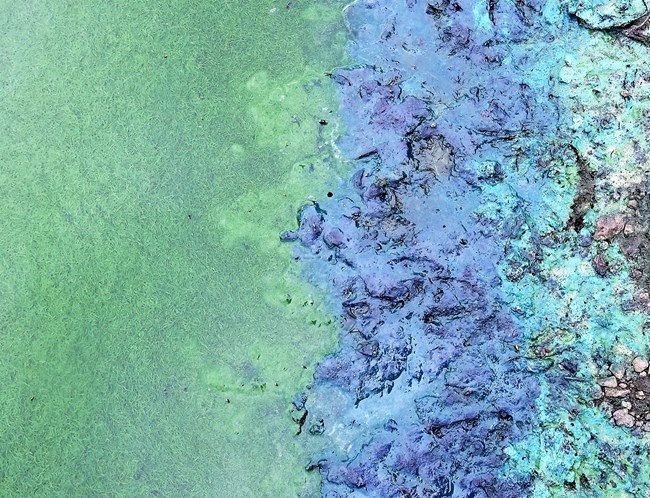
CC Rosser1954 - Cyanobacteria covered water and shoreline, St Margaret's Loch, Holyrood Park, Edinburgh. Though these strange species make look strange or gross to some, we may owe them a debt. Many scientists suspect that when primitive Earth was much hotter, the Blue-Green Algaes photosynthetic evolution made them instrumental in creating the atmosphere. This allowed a major evolutionary transformation leading to the development of aerobic metabolism and to the subsequent rise of higher plant and animal forms. OstracodsThe next featured residents of our thermal springs are the Ostracods. The arthropods of the class Ostracoda are one of the most successful crustacean groups with over 8000 living species. They have adapted to all kinds of wet environments including marine, freshwater, thermal and even some terrestrial habitats such as moss. 
Photography by Geoscientist-in-the-Park (GIP) interns Meg O’Connor and Paul Solis and supervised by Shelley Todd, Natural Resource Manager for Hot Springs National Park
Ostracods have been noticed in our thermal springs ecosystem as early as 1804 when scientists William Dunbar and Dr. George Hunter were sent to explore "the hot springs on the washita" by President Thomas Jefferson right after the Louisiana Purchase. They mentioned in their journal seeing a small "animalcule" in the hot springs pools.
Ostracods are no longer called "animalcules" but they are sometimes called “seed shrimp” and most of them are about the size of a poppy seed. They can range in size from 0.1 to 32 mm. Though Ostracods are not quite as resilient to high heat as some of the other residents of our waters, they can survive temperatures up to 120 degrees F (49 degrees C). These Crustaceans have 5 to 7 pairs of appendages which are specialized for different tasks and they live inside a shell made of two valves which they shed several times during their life, growing a new larger one each time. Ostracods are sexually dimorphic meaning that the males and females are different shapes.These tiny thermophilic animals have a wide range of diets, and the group includes carnivores, herbivores, scavengers and filter feeders. Thermophilic BacteriaThermophilic bacteria are those that thrive within high temperatures, usually between 45 and 80 C (113 and 176F) and are found in environments such as hot springs, peat bogs, and near deep-sea hydrothermal vents. One type of "hyperthermophile", Methanopyrus kandleri, can even survive temperatures up to 122°C. (251.6°F)' which is far above the boiling point of water. Hot Springs National park’s geothermal hot springs are an ideal environment for some species of these heat loving bacteria. 
USDA
We are still learning so much about these fascinating organisms. They "eat" chemical elements such as sulfur and hydrogen and they can fix their own carbon from carbon dioxide. Scientists studying Hot Springs National Park’s thermal waters have currently identified two different species of thermophilic bacteria inhabiting the springs, Thermoanaerobaculum aquaticum and Fontimonas thermophile.The world is filled with many different types of bacteria and though they are traditionally seen as agents of disease, the amount of bacteria that harm humans is very low compared to the thousands of types of bacteria that surround us. The thermophilic bacteria found within Hot Springs National Park belong to the latter group and pose no risk to human health. Nanobacteria 

Left image
Right image
NanobacteriaNanobacteria, (right slide), are the smallest cell-walled organisms on Earth, the existence of which is the center of great controversy. A nanobacterium is around one billionth of a meter in diameter (1/10 the size of bacteria), leaving some to question whether or not they are big enough to hold all the necessary cell components such as DNA, RNA, and plasmids. The rock pictured above was a portion of meteorite ALH84001 that was dislodged from Mars by a huge impact about 16 million years ago and fell to earth about 13,000 years ago. The meteorite was discovered in Antartica in 1984. Scientists from NASA found organic carbon compounds, (what appeared to be impossibly tiny fossilized bacterium), on the surface of the meteorite. The presence of these preserved microscopic physical biomarkers supported a strategy of searching for evidence of life in hot spring deposits on Mars. Because of this they chose 5 thermal springs sites around the world to study and look for "nanobacteria". Two of those were Yellowstone National Park and Hot Springs National Park. When they studied our thermal springs they found what appeared to be over 700 unique nanobes, several of which seemed very similar to those found on the surface of the Mars meteorite. 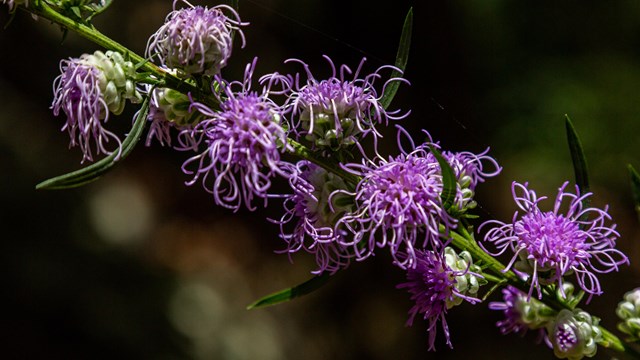
Unique Plants
Many unique plants have adapted to life near the thermal springs. Learn more. 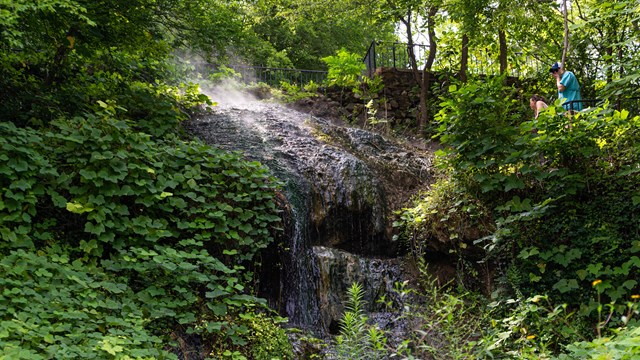
Hot Springs Geology
The story of the Park's thermal springs begins with rocks that formed over 400 million years ago... 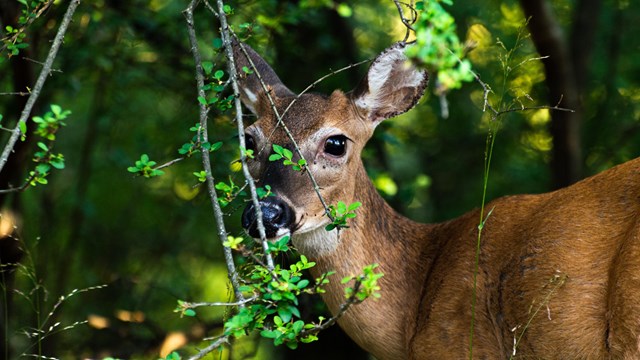
Wildlife
Learn about the wildlife in the Park. |
Last updated: October 7, 2021
